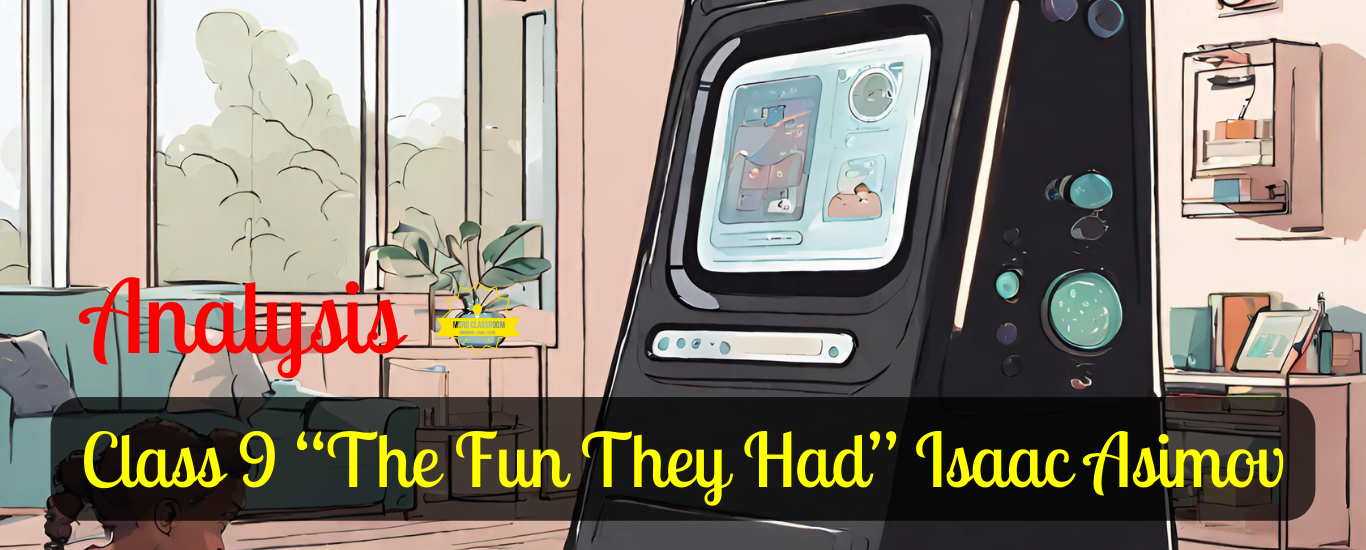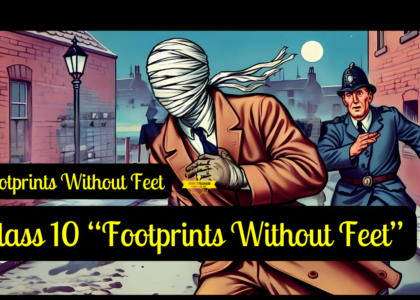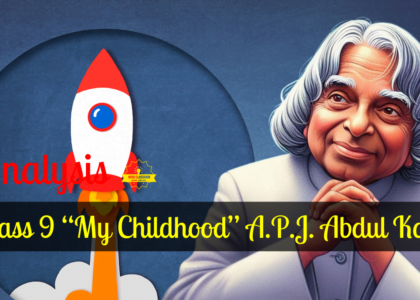Chapter 1, Isaac Asimov’s The Fun They Had Summary, Theme, Character Sketches, Important Passages, Questions Answers and Extra Questions.
Table of Contents
Next: “The Road Not Taken” by Robert Frost
Vocabulary:
- Betray – to reveal or make known unintentionally; to show evidence of.
- Conform – to comply with rules, standards, or expectations; to behave according to prevailing customs or conventions.
- Dispute – to engage in argument or debate; to disagree or challenge.
- Flashing – appearing suddenly or briefly to emit brief bursts of light or information.
- Loftily – in a superior or condescending manner; arrogantly.
- Nonchalantly – in a casually calm and relaxed manner; unconcerned or indifferent.
- Pronouncing – saying or uttering words or sounds in the correct or accepted way; articulating.
- Scornful – feeling or expressing contempt or ridicule; disdainful.
- Sorrowfully – in a manner expressing or showing sadness or regret.
- Superior – higher in rank, status, or quality; greater or better than others in a particular aspect.
Summary “The Fun They Had”:
In “The Fun They Had” by Isaac Asimov, set in 2157, Margie and Tommy discover a printed book about an old-fashioned school, contrasting with their automated education system. Margie dislikes her mechanical teacher, who adjusts poorly to her learning pace. Tommy explains the old school system, where children learned together in a physical building with human teachers. Despite Margie’s initial scepticism, she becomes intrigued by traditional schooling. However, she’s called to her automated lesson, leaving her longing for the communal and interactive learning experiences of the past. Asimov explores technology, education, and nostalgia themes, highlighting the potential drawbacks of overly mechanised learning environments.
Theme “The Fun They Had”:
The theme of Isaac Asimov’s “The Fun They Had” revolves around the contrast between traditional forms of education and futuristic, mechanised methods. It explores the implications of technological advancement on learning, human connection, and individuality.
- Loss of Human Connection: The story highlights the absence of interpersonal interactions and communal learning experiences in the futuristic setting. Children like Margie and Tommy are isolated from their peers and taught by impersonal, mechanical teachers, leading to a lack of socialisation and shared learning experiences.
- Critique of Overreliance on Technology: Asimov critiques the overreliance on technology for education, suggesting that it can lead to a loss of critical thinking skills, creativity, and emotional intelligence. The mechanical teacher in the story symbolises the dehumanising effects of excessive technological dependence.
- Nostalgia: Through Margie’s fascination with the old-fashioned book and traditional school setting, the story evokes a sense of nostalgia for simpler times when education was more personal and communal. Technological advancements may only improve educational quality or overall well-being.
- Resistance to Change: Margie’s initial resistance to the mechanical teacher and her curiosity about the outdated educational practices reflect a broader theme of resistance to change. The story explores how individuals may struggle to adapt to new technologies and cling to familiar customs, even when they recognise the limitations of the old ways.
“The Fun They Had” explores themes of technological advancement, human connection, and the impact of innovation on education and society. It prompts readers to consider the balance between progress and tradition and the importance of maintaining meaningful interpersonal relationships in an increasingly mechanised world.
Character Sketches:
Margie:
Margie is an eleven-year-old girl who serves as one of the main characters in “The Fun They Had” by Isaac Asimov. Here’s a character sketch based on her portrayal in the story:
- Curious and Imaginative: Margie is curious about the past and intrigued by the idea of traditional schools, which contrasts with the mechanical education system she experiences. She shows a vivid imagination, as seen in her interest in the old book and her desire to learn more about outdated educational practices.
- Independent Thinker: Margie demonstrates independence of thought by questioning the effectiveness of the mechanical teacher and expressing dissatisfaction with her education. She challenges the status quo and desires a more engaging and personal learning experience.
- Emotionally Sensitive: Margie’s emotions fluctuate throughout the story, ranging from curiosity and excitement to disappointment and longing. She feels frustrated by her struggles with the mechanical teacher and nostalgic for the communal learning environment of the past.
- Resilient: Despite her frustrations with the mechanical teacher and the limitations of her futuristic education, Margie remains resilient. She continues to seek knowledge and connection, as evidenced by her interest in reading old books and her desire to learn alongside her friend, Tommy.
- Symbol of Lost Childhood: Margie symbolises the loss of childhood innocence and wonder in a highly mechanised society. Her yearning for the simple pleasures of traditional schooling reflects a longing for a time when education was more personal and meaningful.
Margie is the main character who embodies curiosity, independence, vulnerability, resilience, and nostalgia in “The Fun They Had.” Her experiences and emotions highlight the story’s exploration of technology, education, and human connection.
Tommy:
In “The Fun They Had” by Isaac Asimov, Tommy is Margie’s thirteen-year-old friend. Here’s a character sketch based on his portrayal in the story:
- Confident and Assertive: Tommy is depicted as confident and assertive, especially in his interactions with Margie. He sometimes displays a sense of superiority, particularly when explaining concepts to Margie or teasing her about her lack of knowledge about the past.
- Tech-Savvy and Knowledgeable: Tommy is familiar with the advanced technology of his time, including telebooks and mechanical teachers. He appears to grasp better how things work in their futuristic society than Margie, as evidenced by his nonchalant attitude towards their educational system.
- Pragmatic and Realistic: Unlike Margie, Tommy seems more accepting of the status quo and less inclined to question the effectiveness of their education system. He takes a pragmatic approach to their circumstances, focusing more on the practical benefits of technology rather than its limitations.
- Loyal Friend: Despite their differences, Tommy is Margie’s faithful friend. He spends time with her, shares his discoveries with her, and even agrees to read the old book after school, albeit casually. His friendship with Margie provides both characters with a sense of companionship and support.
- Limited Understanding of the Past: While Tommy is knowledgeable about the technology and education system of their time, he needs a deeper understanding of the past. He dismisses Margie’s curiosity about traditional schools and appears to view them as outdated relics of the past.
Tommy is portrayed as a confident, pragmatic, and tech-savvy character who contrasts Margie’s curiosity and emotional vulnerability. His friendship with Margie adds depth to the story and highlights different attitudes towards technology and education in their futuristic society.
Important Lines/ Passages “The Fun They Had”:
1. “Margie even wrote about it that night in her diary. On the page headed 17 May 2157, she wrote, ‘Today Tommy found a real book!” This passage introduces Tommy’s discovery of a physical book, a rare occurrence in a future where education is primarily conducted electronically. Margie’s excitement is evident as she records the event in her diary, marking it as a significant moment.
2. “They turned the pages, which were yellow and crinkly, and it was awfully funny to read words that stood still instead of moving the way they were supposed to — on a screen, you know.” Here, Margie and Tommy explore the book, marvelling at its physicality and the novelty of reading words on paper rather than on a screen. The passage highlights their amusement and curiosity as they experience a form of education that differs from their usual electronic lessons.
3. “Margie was scornful. ‘School? What’s there to write about school? I hate school.” Margie expresses her disdain for the mechanical and impersonal nature of her futuristic schooling. Her negative attitude towards school reflects a dissatisfaction with the educational system and hints at her longing for a more engaging and enjoyable learning experience.
4. “The mechanical teacher had been giving her test after test in geography and she had been doing worse and worse…” This passage reveals Margie’s struggles with her mechanical teacher, particularly in geography. Despite repeated tests, her performance continues to decline, indicating a disconnect between the teaching method and her ability to grasp the material.
5. “Margie had hoped he wouldn’t know how to put it together again, but he knew how all right…” Margie’s disappointment is evident as she realises that the County Inspector can repair the mechanical teacher, preventing her from being rid of it altogether. This passage highlights Margie’s desire to escape the confines of her automated education and regain control over her learning experience.
6. “Margie was disappointed. She had been hoping they would take the teacher away altogether.” Margie’s disappointment stems from her desire to eliminate the mechanical teacher, indicating her dissatisfaction with her futuristic education’s impersonal and ineffective nature. This passage highlights her longing for a more traditional and engaging form of learning.
7. “Margie wasn’t prepared to dispute that. She said, ‘I wouldn’t want a strange man in my house to teach me.” Margie expresses her reluctance to accept the idea of a human teacher, highlighting her discomfort with learning from someone unfamiliar. This passage reflects her scepticism towards traditional forms of education and her preference for the familiarity of the mechanical teacher despite its shortcomings.
8. “Margie went into the schoolroom. It was right next to her bedroom, and the mechanical teacher was on and waiting for her.” This passage depicts the routine nature of Margie’s education, with the mechanical teacher always ready and waiting for her in the adjacent schoolroom. It reinforces the idea of a highly structured and automated educational system devoid of spontaneity or personalisation.
9. “Today’s arithmetic lesson is on the addition of proper fractions. Please insert yesterday’s homework in the proper slot.” The passage illustrates the mechanical teacher’s systematic approach to instruction, prompting Margie to insert her completed homework into the designated slot before beginning the lesson. It emphasises the repetitive and controlled nature of Margie’s education under the mechanical teacher.
10. “The mechanical teacher was flashing on the screen: ‘When we add fractions ½ and ¼…” This passage further demonstrates the mechanical teacher’s role in delivering lessons through a screen, reinforcing the theme of technological dominance in education. It highlights the mechanical teacher’s ability to present information in a programmed and systematic manner, devoid of human interaction or adaptability.
11. “She was thinking about the old schools they had when her grandfather’s grandfather was a little boy. All the kids from the whole neighborhood came, laughing and shouting in the schoolyard, sitting together in the schoolroom, going home together at the end of the day.” Margie reminisces about traditional schools’ communal and lively atmosphere, contrasting it with her futuristic education’s isolated and sterile environment. This passage highlights her longing for human connection and shared learning experiences.
12. “Margie was thinking about the fun they had.” This final passage encapsulates Margie’s wistful nostalgia for the joy and camaraderie of traditional schooling. It emphasises her desire for a more engaging and fulfilling educational experience, characterised by genuine human interaction and spontaneity.
Questions Answers “The Fun They Had”:
Thinking About The Text:
I. Answer these questions in a few words or a couple of sentences each.
1. How old are Margie and Tommy?
A1: Margie is eleven years old, and Tommy is thirteen years old.
2. What did Margie write in her diary?
A2: Margie wrote in her diary about Tommy finding an actual book.
3. Had Margie ever seen a book before?
A3: Margie had never seen a book before the one Tommy found.
4. What things about the book did she find strange?
A4: Margie found it strange that the words in the book stood still instead of moving on a screen and remained the same when the page was turned back.
5. What do you think a telebook is?
A5: A telebook is likely a digital or electronic book displayed on a screen instead of a physical book.
6. Where was Margie’s school? Did she have any classmates?
A6: Margie’s school was in her house, and she had no classmates because a mechanical teacher conducted her education.
7. What subjects did Margie and Tommy learn?
A7: Margie and Tommy learned subjects such as geography, arithmetic, and presumably other standard school subjects typically taught by mechanical teachers in their futuristic setting.
II. Answer the following with reference to the story.
1. “I wouldn’t throw it away.”
(i) Who says these words?
(ii) What does ‘it’ refer to?
(iii) What is it being compared with by the speaker?
Answers:
(i) Tommy says these words.
(ii) ‘It’ refers to the physical book that Tommy found.
(iii) The speaker is comparing the physical book to the telebooks they are used to, indicating that he wouldn’t throw away a physical book like he would discard a telebook.
2. “Sure they had a teacher, but it wasn’t a regular teacher. It was a man.”
(i) Who does ‘they’ refer to?
(ii) What does ‘regular’ mean here?
(iii) What is it contrasted with?
Answers:
(i) ‘They’ refers to the children who attended school in the past, as mentioned in the book Margie and Tommy found.
(ii) ‘Regular’ here means conventional or typical.
(iii) This contrasts with the mechanical teacher system used in Margie and Tommy’s time, in which teachers were machines rather than human beings.
III. Answer these questions in a short paragraph (about 30 words).
1. What kind of teachers did Margie and Tommy have?
A1: In their futuristic education system, Margie and Tommy had mechanical teachers, not human ones.
2. Why did Margie’s mother send for the County Inspector?
A2: Margie’s mother sent for the County Inspector because Margie performed poorly in geography.
3. What did he do?
A3: The County Inspector adjusted Margie’s mechanical teacher to a slower pace.
4. Why was Margie doing badly in geography? What did the County Inspector do to help her?
A4: Margie was doing poorly in geography because the mechanical teacher was too fast. The County Inspector slowed down the pace to help her.
5. What had once happened to Tommy’s teacher?
A5: Tommy’s teacher had once been taken away for nearly a month because the history sector had blanked out completely.
6. Did Margie have regular days and hours for school? If so, why?
A6: Yes, Margie had regular days and hours for school to ensure consistent learning, as her mother believed it would help her learn better.
7. How does Tommy describe the old kind of school?
A7: Tommy describes the old kind of school as having all the kids from the neighborhood come together, laugh, and shout in the schoolyard, sitting together in the schoolroom, and go home together.
8. How does he describe the old kind of teachers?
A8: Tommy describes the old kind of teachers as men who tell the boys and girls things, give them homework, and ask them questions.
IV. Answer these questions in two or three paragraphs (100 –150 words).
Q1: What are the main features of the mechanical teachers and the schoolrooms Margie and Tommy have in the story?
A1: In “The Fun They Had,” the mechanical teachers and schoolrooms that Margie and Tommy have are characterised by their futuristic and automated nature. The mechanical teachers are large, black, and ugly machines with screens showing lessons and asking questions. They are equipped with slots for inserting homework and test papers, which are then graded automatically.
The lessons are delivered systematically and repetitively, needing more adaptability and personalisation of human teachers. The schoolrooms are adjacent to the children’s bedrooms, indicating a seamless integration of education into their daily lives. These mechanical teachers and schoolrooms represent a highly structured and technologically driven approach to teaching, devoid of human interaction and spontaneity.
Q2: Why did Margie hate school? Why did she think the old kind of school must have been fun?
A2: Margie hated school because she was dissatisfied with the mechanical teacher system. She found the mechanical teacher impersonal and ineffective, as evidenced by her declining performance in geography despite repeated tests. Margie’s negative experience with the mechanical teacher led to her overall disdain for school. She longed for the more engaging and communal learning experiences of the past, as depicted in the old-fashioned book.
Margie imagined the old kind of school as a place where children from the neighborhood came together, laughing and shouting in the schoolyard, sitting together in the schoolroom, and going home together at the end of the day. She believed that the traditional school setting fostered camaraderie, shared learning experiences, and genuine human connection, which she found lacking in her mechanised education.
Q3: Do you agree with Margie that schools today are more fun than the school in the story? Give reasons for your answer.
A3: As a class 9 student, I believe schools today are generally more fun than those depicted in “The Fun They Had.” In modern schools, we can access various interactive technologies, hands-on learning experiences, and extracurricular activities that make learning engaging and enjoyable. Modern schools often promote creativity, critical thinking, and student collaboration, encouraging a dynamic and stimulating learning environment.
While the school in the story may have had elements of novelty, such as physical books and communal learning, education’s rigid and mechanised nature would likely become boring and monotonous over time. I prefer contemporary schools’ diverse and interactive learning opportunities, providing a more enjoyable and enriching educational experience.
Thinking About Language:
1. Find the sentences in the lesson which have the adverbs given in the box below
Following are the sentences from the story that contain the adverbs listed:
A: Following are the sentences where the mentioned adverbs were used:
- “It was awfully funny to read words that stood still instead of moving the way they were supposed to — on a screen, you know.”
- “Margie’s mother had shaken her head sorrowfully and sent for the County Inspector.”
- “They had once taken Tommy’s teacher away for nearly a month because the history sector had blanked out completely.”
- “He added loftily, pronouncing the word carefully, ‘Centuries ago.”
- “But my mother says a teacher has to be adjusted to fit the mind of each boy and girl it teaches and that each kid has to be taught differently.”
- “Margie said quickly, ‘I didn’t say I didn’t like it.”
- “Maybe,” he said nonchalantly. He walked away whistling, the dusty old book tucked beneath his arm.
2. Now use these adverbs to fill in the blanks in the sentences below.
i) The report must be read carefully so that performance can be improved.
(ii) At the interview, Sameer answered our questions nonchalantly, shrugging his shoulders.
(iii) We all behave differently when we are tired or hungry.
(iv) The teacher shook her head sorrowfully when Ravi lied to her.
(v) I quickly forgot about it.
(vi) When I complimented Revathi on her success, she just smiled loftily and turned away.
(vii) The President of the Company is awfully busy and will not be able to meet you.
(viii) I finished my work quickly so that I could go out to play.
3. Make adverbs from these adjectives.
| Adjectives | Adverbs |
| Angry | Angrily |
| Happy | Happily |
| Merry | Merrily |
| Sleepy | Sleepily |
| Easy | Easily |
| Noisy | Noisily |
| Tidy | Tidily |
| Gloomy | Gloomily |
II. If Not and Unless:
Complete the following conditional sentences. Use the correct form of the verb.
- If I don’t go to Anu’s party tonight, I will miss all the fun.
- If you don’t telephone the hotel to order food, you will have nothing to eat for dinner.
- Unless you promise to write back, I will be worried about you.
- If she doesn’t play any games, she will get bored.
- Unless that little bird flies away quickly, the cat will catch it.
Writing:
A new revised volume of Issac Asimov’s short stories has just been released. Order one set. Write a letter to the publisher, Mindfame Private Limited, 1632 Asaf Ali Road, New Delhi, requesting that a set be sent to you by Value Payable Post (VPP) and giving your address. Your letter will have the following parts.
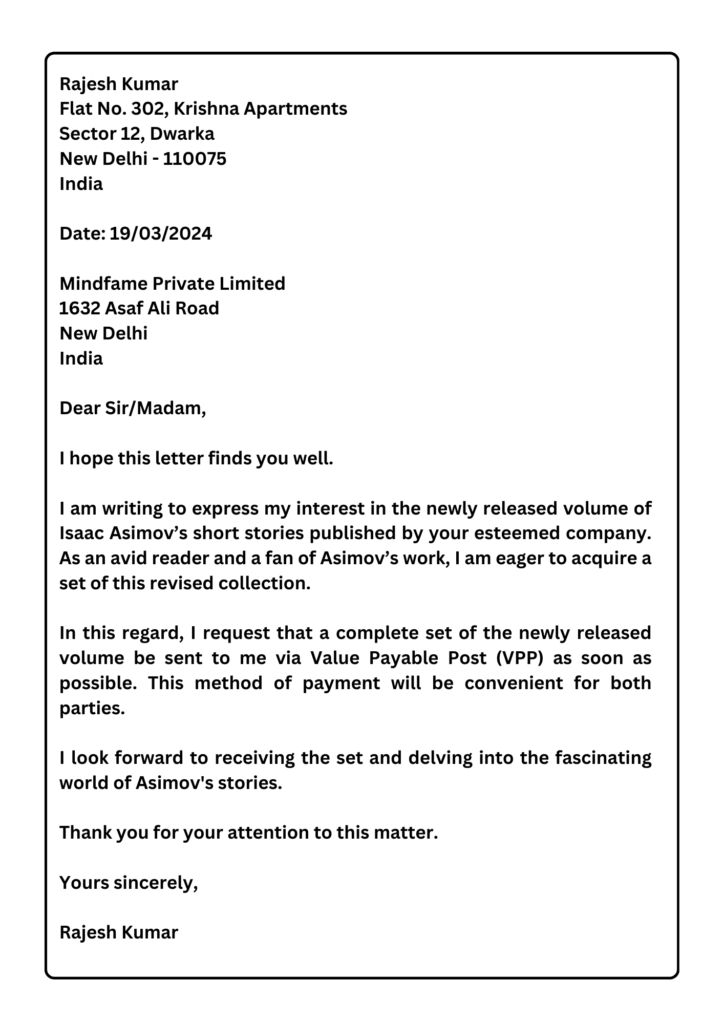
Speaking:
In groups of four, discuss the following topic.
‘The Schools of the Future Will Have No Books and No Teachers!’
When students are preparing to argue for or against the topic “The Schools of the Future Will Have No Books and No Teachers,” they should consider several points to strengthen their arguments:
For Example:
For the motion (schools will have no books and no teachers):
- Embrace technology: Highlight the benefits of digital learning resources such as interactivity, accessibility, and updated content.
- Efficiency: Discuss how AI and automation can personalise learning experiences, cater to individual student needs, and optimise educational outcomes.
- Cost-effectiveness: Point out the potential cost savings associated with digital resources compared to traditional textbooks and classroom infrastructure.
- Future readiness: Argue that preparing students for a technology-driven world requires adapting educational methods to reflect contemporary practices.
- Environmental impact: Emphasize the sustainability benefits of reducing paper usage and minimising the ecological footprint of education.
Against the motion (schools will maintain books and teachers):
- Human interaction: Stress the importance of face-to-face interactions with teachers for emotional support, mentorship, and social development.
- Critical thinking: Argue that traditional teaching methods foster crucial thinking skills and encourage deeper understanding through discussions, debates, and collaborative activities.
- Equity and access: Highlight concerns about the digital divide and ensure all students have equal access to technology and digital resources.
- Cultural and historical significance: Acknowledge the value of physical books in preserving cultural heritage, fostering a love of reading, and providing a tangible connection to knowledge.
- Classroom dynamics: Discuss the role of teachers as facilitators of learning, mentors, and role models in creating supportive and inclusive learning environments.
By considering these points, students can construct well-rounded arguments and engage in a thoughtful debate on the topic.
Sample: Group discussion
Speaker 1 (For the motion):
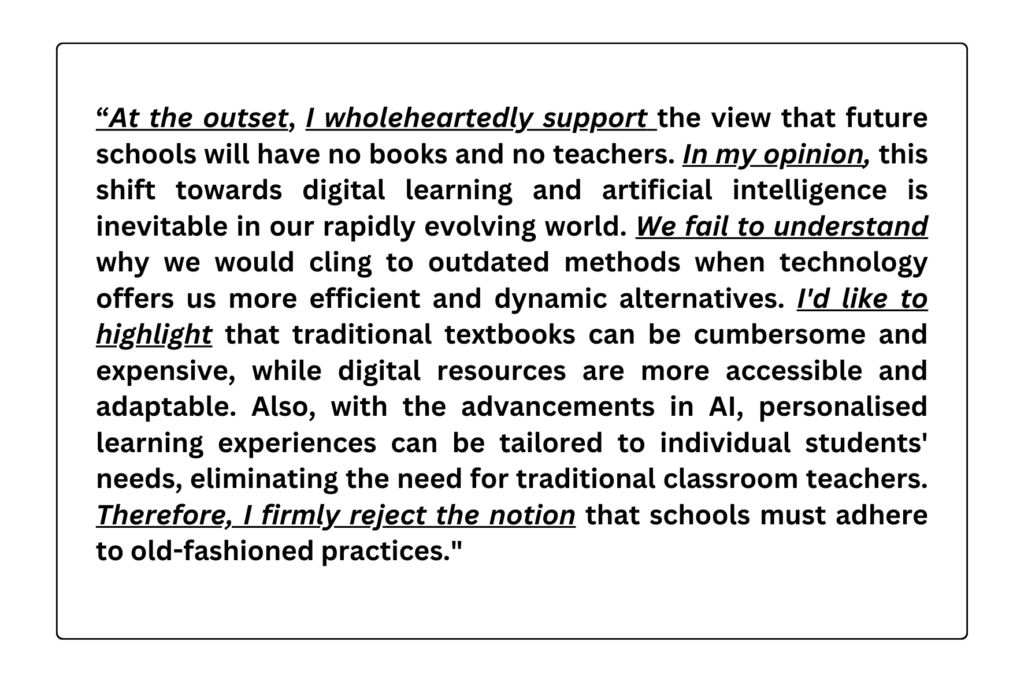
Speaker 2 (Against the motion):
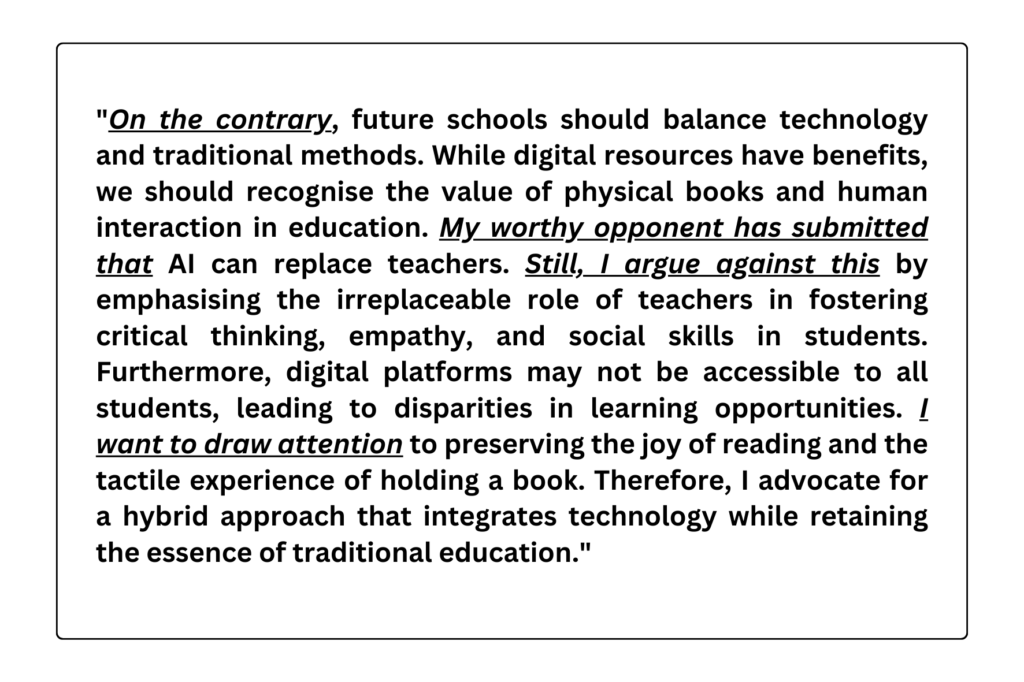
Extra Questions “The Fun They Had”:
Short Answer Type Questions:
Q1: What did Margie write about in her May 17, 2157 diary?
A1: Margie documented Tommy’s exciting discovery of a tangible, physical book. This was a rare occurrence in their highly digitised world, marking a departure from their usual learning mode via screens and electronic devices. The event left a significant impression on Margie, enough for her to record it in her diary.
Q2: Where did Tommy find the old book?
A2: Tommy stumbled upon the ancient book within the confines of his own home, specifically in the attic. The attic, often a repository for forgotten relics of the past, yielded this treasure, offering a glimpse into a bygone era.
Q3: What was Margie’s initial reaction to the book being about school?
A3: Margie expressed disdain at the idea of a book centred around school, reflecting her existing aversion to the educational system. Her scepticism stemmed from her negative experiences with the mechanical teacher, predisposing her to reject anything related to traditional schooling.
Q4: How did Margie feel about her mechanical teacher?
A4: Margie harboured a deep-seated dislike for her mechanical teacher, primarily due to its impersonal nature and rigid structure. She resented the mechanical teacher’s method of grading homework and tests, which involved using a punch code, finding it tedious and uninspiring.
Q5: What did the County Inspector do to Margie’s mechanical teacher?
A5: Upon assessment, the County Inspector recognised the mismatch between Margie’s pace of learning and the accelerated rate of the geography sector in her mechanical teacher. He adjusted to slow down the pace to a level more suitable for Margie’s comprehension, ensuring a better alignment between her abilities and the curriculum.
Q6: How did Tommy describe the old school in the book?
A6: Tommy portrayed the antiquated school system depicted in the book as fundamentally different from their current setup. He highlighted the presence of human teachers, a communal learning environment, and a collective curriculum where all students learned together in a physical space, contrasting starkly with their individualised, technologically driven education.
Q7: According to Tommy, why did all the kids learn the same thing in the old schools?
A7: Tommy explained that in the old schools, uniformity in learning stemmed from all children attending being of the same age group. This ensured that the curriculum catered to their collective needs and abilities, facilitating a cohesive learning experience for everyone.
Q8: What was Margie’s mother’s opinion on teaching methods?
A8: Margie’s mother believed effective teaching required a personalised approach tailored to each child’s unique learning style and pace. She emphasised the importance of individualised instruction, indicating a preference for methods catering to specific needs rather than a one-size-fits-all approach.
Q9: How did Margie feel about attending school after reading about the old schools?
A9: Margie’s encounter with the depiction of traditional schools evoked nostalgia and longing for a different educational experience. She yearned for the camaraderie and shared learning of the past, contrasting it with her current solitary, mechanised education, which left her feeling disconnected and unfulfilled.
Q10: What was Margie thinking about as she sat before her mechanical teacher?
A10: As Margie sat before her mechanical teacher, she couldn’t help but reminisce about the old-fashioned schools described in the book. She reflected on the sense of community, collaboration, and joyous learning that seemed absent from her current educational setup, fostering a desire for a more humanised approach to education.
Q11: How did Margie and Tommy react differently to discovering the old book?
A11: Margie was intrigued by the novelty of finding a physical book and expressed curiosity about its contents. At the same time, Tommy initially dismissed it as a waste, preferring the efficiency of their digital learning tools.
Q12: Why did Margie’s mechanical teacher frustrate her?
A12: Margie found her mechanical teacher frustrating because of its impersonal nature and the tedious process of submitting homework and test papers through a slot, which needed more warmth and understanding from a human teacher.
Q13: How did Margie’s perception of traditional schooling change throughout the story?
A13: Initially sceptical, Margie became increasingly intrigued by traditional schooling as she learned more about it from the old book. She longed for the sense of community and shared experiences described in the book, contrasting it with her solitary, mechanised education.
Q14: What role did nostalgia play in Margie’s thoughts about traditional schooling?
A14: Nostalgia played a significant role in Margie’s thoughts as she yearned for the communal learning and human interaction of traditional schools depicted in the old book. The contrast between her current education and the idealised past fueled her longing for a more authentic and meaningful learning experience.
Q15: How did the portrayal of traditional schools in the old book influence Margie’s perception of education?
A15: The portrayal of traditional schools in the old book sparked Margie’s curiosity and imagination, leading her to question the efficiency and impersonality of her current education. It prompted her to reevaluate her understanding of learning and yearn for a more humanised and engaging educational experience.
Long Answer Type Questions:
Q1: How does Margie react when Tommy finds a real book? What does she find funny about it?
A1: Margie reacts excitedly when Tommy finds a real book documenting the event in her diary. She finds it amusing that the words on the pages remain still, unlike the moving words on a screen. This static nature of the printed words strikes her as peculiar because she’s accustomed to dynamic screens.
The novelty of encountering a physical book adds to her amusement. Despite eleven years old, Margie has yet to see many telebooks like Tommy, contributing to her fascination with the traditional book format. Thus, Margie’s reaction blends curiosity and amusement as she explores the old-fashioned medium of printed text alongside Tommy.
Q2: What is Tommy’s opinion on the book compared to telebooks? How does Margie’s viewpoint differ from Tommy’s?
A2: Tommy views the discovery of the real book with indifference, considering it a waste compared to telebooks. He sees telebooks as superior due to their versatility, with one screen containing numerous books. Tommy perceives physical books as disposable after use, contrasting with the seemingly endless possibilities of telebooks.
In contrast, Margie is intrigued by the novelty of the real book, finding amusement in its static words and different format from telebooks. Margie’s viewpoint reflects a sense of wonder and curiosity, appreciating the uniqueness of the traditional book medium compared to the ubiquitous telebooks. Thus, while Tommy dismisses the real book in favour of telebooks, Margie finds value and fascination in the tangible, printed text.
Q3: Why does Margie hate school? Describe her experience with the mechanical teacher and the County Inspector.
A3: Margie hates school due to her deteriorating performance under the mechanical teacher’s instruction. The mechanical teacher administers tests relentlessly, exacerbating Margie’s frustration as her scores decline. Her mother’s disappointment leads to the intervention of the County Inspector, who, despite Margie’s hopes, repairs the mechanical teacher. Margie finds the mechanical teacher cumbersome and unpleasant, especially the slot for submitting homework and tests encoded in punch cards.
The County Inspector adjusts the mechanical teacher to a slower pace but reaffirms its overall effectiveness. Margie’s negative experience with the mechanical teacher contributes to her disdain for school, as it fails to engage her and adapt to her individual learning needs, unlike the more personalised approach she imagines from the past.
Q4: How does the County Inspector adjust Margie’s mechanical teacher? What is Margie’s reaction to his intervention?
A4: The County Inspector adjusts Margie’s mechanical teacher by slowing down its pace to match a ten-year-old’s level, particularly in the geography sector where Margie struggled. Despite Margie’s hopes that the Inspector might dismantle the mechanical teacher altogether, he only modifies its settings to address her difficulties.
Initially disappointed by the Inspector’s decision not to remove the mechanical teacher entirely, Margie finds solace in his reassurance that her overall progress is satisfactory. While the adjustment may alleviate some of Margie’s immediate frustrations, it doesn’t fully address her dissatisfaction with her mechanical teacher’s impersonal and inflexible nature, reinforcing her longing for a more humanised and adaptable educational experience.
Q5: What does Tommy reveal about the old-school system to Margie? How does Margie respond to this revelation?
A5: Tommy reveals to Margie that teachers are humans rather than machines in the old-school system. He explains that students attended a separate building where a single teacher, typically a man, imparted knowledge, assigned homework, and asked questions. Margie initially expresses scepticism about the effectiveness of a human teacher, questioning their intelligence compared to the mechanical teacher.
However, Tommy defends the old-school system, highlighting that his father knows as much as his teacher. While Margie remains uncertain about having a stranger teach her at home, she becomes intrigued by the idea of a different educational approach. She desires to learn more about the funny schools described in the book.
Q6: How does Tommy explain the role of teachers in the old-school system? What is Margie’s initial reaction?
A6: Tommy explains that in the old-school system, teachers directly interacted with students, imparting knowledge, assigning homework, and asking questions. He contrasts this with Margie’s experience with the mechanical teacher, emphasising the personal touch and direct engagement of human teachers. Margie initially responds with scepticism, questioning the intelligence and effectiveness of a human teacher compared to a mechanical one. However, Tommy counters by pointing out that his father knows as much as his teacher, suggesting that human teachers are indeed knowledgeable. While Margie remains hesitant about having a stranger teach her at home, she becomes intrigued by the concept of a different educational approach, indicating a willingness to explore further.
Q7: How does Margie challenge Tommy’s explanation regarding the effectiveness of a male teacher? What is Tommy’s response?
A7: Margie challenges Tommy’s explanation regarding the effectiveness of a male teacher by expressing doubt about a man’s capability to teach. She questions how a man could possess sufficient intelligence to educate children, given her perception that only machines like mechanical teachers are smart enough. Margie’s scepticism stems from her reliance on the mechanical teacher and her belief in its superiority over humans.
However, Tommy confidently asserts that his father knows as much as his teacher, implying that intelligence is not limited to machines. Tommy’s response challenges Margie’s preconceived notions, suggesting that human teachers could effectively educate students despite her initial scepticism.
Q8: How does Margie’s mother influence her perception of learning? How does this differ from the old-school system described in the book?
A8: Margie’s mother influences her perception of learning by emphasising the importance of regularity and consistency in education. She insists on Margie adhering to a strict schedule, with the mechanical teacher always on at the same time every day except weekends. Margie’s mother believes children learn better in structured, predictable learning environments. This approach contrasts with the old-school system described in the book, where children attended a separate building and learned with a human teacher.
In the old school system, learning was more communal and flexible, with children from the neighbourhood interacting and collaborating on their studies. Unlike Margie’s regimented learning experience, the old school system allowed for more interpersonal connections and spontaneous learning opportunities.
Q9: What is Margie’s sentiment towards the mechanical teacher as she goes to school? How does she compare it to the old-school system?
A9: As Margie goes to school, her sentiment towards the mechanical teacher is resignation and disappointment. She finds the mechanical teacher cumbersome and unpleasant, as it administers tests relentlessly and fails to engage her effectively. Margie’s experience with the mechanical teacher contrasts sharply with her nostalgic thoughts about the old-school system.
She longs for the communal and personalised learning environment of the past, where children interacted with a human teacher and each other. Margie imagines the old-school system as more enjoyable and fulfilling, where learning is not confined to rigid schedules and impersonal machines. Thus, while Margie feels disillusioned by the mechanical teacher, she romanticises the old-school system as a more enriching educational experience.
Q10: What memories does Margie recall about the old-school system while participating in her modern-day lessons? How does this contrast with her current educational experience?
A10: While participating in her modern-day lessons, Margie recalls memories of the old-school system with longing and nostalgia. She reminisces about the lively schoolyard where children laughed and played together and the camaraderie they shared while studying and discussing homework. Margie fondly remembers the human teachers who imparted knowledge and interacted with students personally.
These memories contrast starkly with her current educational experience, dominated by the mechanical teacher and rigid schedules. Margie yearns for the personalised and communal learning environment of the past, where education was more engaging and fulfilling. The contrast highlights Margie’s dissatisfaction with the impersonal nature of her current education and her longing for a more humanised approach to learning.

